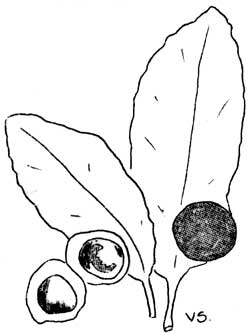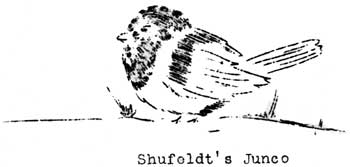
Every fisherman who has pushed his way through willow thickets along
a stream has noticed the smooth, round red-and-green swellings on the
leaves of this tree. At first glance these might be mistaken for
brilliantly colored fruits hanging from the branches, but closer
examination reveals the fact that the swellings have been formed
directly from the tissue of the leaf. An abnormal warty growth of this
type is known as a gall, and may be likened to a cancerous
growth in human tissue caused by local irritation. An individual willow
leaf usually bears but one or two galls, although occasionally as
many as eight are found, and there may be several dozen infested leaves
on a single bush. The average diameter of a full-grown gall is one-half
inch, rising about equally above the lower and upper surfaces of the
leaf. Young galls are green in color, later turning to bright red.
As remarkable as the outer appearance of the gall is the fact that
each forms a one-room chamber housing the larva of an insect. Hatching
from an egg buried in the tissue of the leaf, a small, white,
worm-like larva starts to feed and grow in size. The irritation
due to the rasping of the larva, or perhaps to some chemical secretion
causes the leaf to grow scar tissue around the spot, eventually
resulting in a round, firm nodule containing a hollow in which the larva
continues to feed until mature. The larva may be easily seen by slicing
off a section of the gall with a knife. In addition to protection from
the drying heat of the sun, the insect finds food and oxygen in its
narrow cell and continues to thrive undisturbed until ready to
pupate.
|
-oOo-
WILLOW LEAF GALL
on upper surface of Salix sp. One gall cut open to show sawfly larva
feeding. (Natural size.)
|

|
When mid-summer arrives, each larva tunnels out of its cell into the
light of day, leaving a telltale opening on the gall and a small pile of
fine, brown pellet-like castings within. After dropping to the soil
underneath the willow tree it burrows just beneath the ground debris and
fashions a new kind of chamber in the form of a thin, parchment-like
brown capsule about the diameter of a match stick and a quarter-inch
long. Here the transformation occurs from the larva to the adult. The
adult sawfly resembles roughly an ordinary housefly in shape and size,
having a robust, shining black body with brownish markings. Tho termed a
"fly" it actually belongs to the order of bees, wasps, and ants
(Hymenoptera) and is distinguished by four wings instead. of the two of
typical flies, as well as by its sharp saw-toothed ovipositor useful in
placing eggs in the center of a leaf. Eggs are laid in the spring when
the leaves of the willow are growing actively and furnish ample food for
the developing larva.
Although willow leaf galls are observed year after year they occur on
a shrub of little economic value and are consequently not classed as
serious pests. The sawfly responsible for the damage is probably held in
check by other insect neighbors of parasitic habits, rather than by a
lack of food supply. As curiosities of the amazing insect world, though,
willow galls will always hold interest for those who hike along tho
river trails about the lower slopes of the Mountain.
(1) Pontania californica Marlatt. (Essig, Insects of Western North
America. (New York, Macmillan), pp. xi, 1055, 766 fig., 1929)
Victor Scheffer,
Ranger-Naturalist, 1934.
-oOo-


